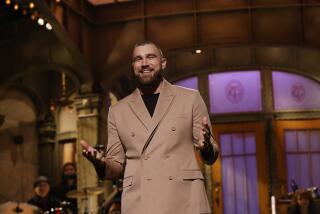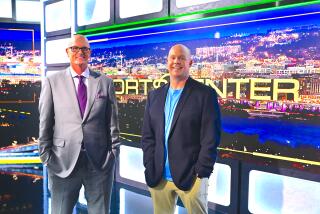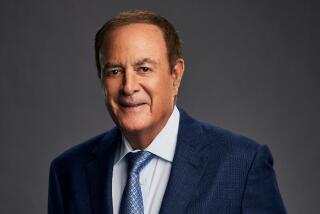2 Oakland Sluggers Top âScouting Reportâ for TV Commercial Rosters
When the 1989 World Series is over, it may be just the beginning of an even more lucrative game for several key athletes: the product endorsement game.
A âscouting reportâ on the best prospects for the âWorld Series of Commercial Endorsementsâ was released on Monday by the San Francisco office of the ad firm Foote, Cone & Belding.
Among the best bets: Oakland outfielders Rickey Henderson and Jose Canseco. âHenderson is the closest thing to a sure thing,â said Geoff Thomas, the ad agencyâs director of creative services. âAnd Canseco would be great for any male-oriented products. Most guys fantasize about getting into the kind of trouble he gets into.â
Athletes everywhere fantasize about big commercial paydays. In 1988, Chicago Bulls basketball star Michael Jordan ranked tops among all athletic pitchmen, according to a survey of 1,000 consumers by the New York research firm Video Storyboard Tests. And while the research firm is still compiling its 1989 annual list of âmost persuasiveâ athletes, sports marketing executives say there is little doubt who will rank No. 1 for 1989--Los Angeles Raider and Kansas City Royal superstar Bo Jackson.
No matter who tops these lists, however, athletes usually make for lousy pitchmen, says Dave Vadehra, president of Video Storyboard Tests, which assembles the annual listing. âPeople are very skeptical of all paid endorsements,â said Vadehra. âI seriously doubt that athletes have any effect in selling products.â
Those words lend little comfort to two companies that last week announced substantial deals with key athletes. L.A. Gear said it had signed âThe Mailmanâ--Utah Jazz forward Karl Malone--to a contract to promote its basketball shoe line in 1990. And Chattem Inc., the Tennessee-based maker of various pharmaceutical products, said it had signed Joe Namath as a pitchman for a new rub-in cream for arthritis sufferers.
âWe can take the Mailman and have him deliver for L.A. Gear,â said Don Wasley, vice president of promotions for the firm. And as for landing Namath as a spokesman for the pain relieving gel Flex-all, Howard Ottley, vice president of Chattem said: âWith all of his injuries, Joe Namath is a natural to be talking about this.â
Some of the biggest names in Los Angeles area athletics have yet to crack Video Storyboardâs Top Ten list, including Magic Johnson, Kareem Abdul-Jabbar, Orel Hershiser, Tommy Lasorda and Pat Riley.
For the past five years, four spokesjocks--O.J. Simpson, John Madden, Dick Butkus and Bob Uecker--have have appeared on every Top 10 list. Why?
Itâs a pretty simple formula, said Bud Stanner, senior vice president at the Cleveland-based sports marketing firm, International Management Co. âFor an active athlete, a big part of it is marquee value. You know, how is the guy doing in his sport?
âBut,â said Stanner, âyou also have to consider if heâs part of a major ad campaign. And if he is, just how well can he deliver a pitch?â
Sports marketing executives say Jordan and Jackson fill the bill in all three areas. And while Jackson is a relative newcomer to commercial endorsements, Jordan this year signed a lifetime contract with Nike that will pay him an estimated $10 million to promote its products for the rest of his sports career.
Is Michael âAirâ Jordan worth it?
âIf we didnât have athletes in our ads, who would we have?â posed Liz Dolan, director of public relations at Nike, which has both Jackson and Jordan pitching its shoes and athletic wear. âOur commercials happen to be about sportswear, so why not use athletes?â
In 1975, when Miller Brewing Co. decided to introduce Miller Lite Beer into the U.S. market, it hired a number of ex-jocks as spokesman. âWe wanted to make sure no one thought this was a sissy beer,â said Robert A. Toledo, vice president of brand promotion at Miller.
Of course, Miller would have prefered to use current athletes, but virtually all major professional sports leagues prohibit athletes from endorsing beer or liquor in ads. Even then, the Miller Lite ads--and the light beer itself--quickly caught the publicâs fancy. Today, one out of four beers sold in America is now a light beer--and Miller Lite is the top seller. And those offbeat Miller Lite ads made household names out of commercial stars Madden, Butkus and Uecker.
But executives say thereâs always a risk in using athletes. Their performances--on or off the field--can wreak havoc on the sales of the products they sponsor.
In the 1984-85 basketball season, when Jordan first signed with Nike to promote its new âAir Jordanâ line basketball shoes, the company reports it sold more than $100 million worth of them.
The following season, when Jordan broke his foot and missed most of the season, sales âseverely dropped,â said Dolan. The next season, with Jordan healed and performing better then ever, sales took off again, she said.
San Diego Charger quarterback Jim McMahon has seen his market value as a product spokesman drop sharply over the past few years. Injuries have been a key factor there.
In 1987, when he was with the Chicago Bears, Video Storyboard ranked him as the nationâs âmost persuasiveâ athlete in TV commercials. By 1988, when injuries began to hobble him, and Taco Bell and Honda used him in fewer ads, McMahon fell to Number Ten.
Through his attorney, McMahon declined to be interviewed. But Steve Zucker, McMahonâs Chicago-based attorney and agent, agreed injuries have hobbled McMahonâs commercial potential. âWhen he is hurt, the offers slow down,â said Zucker. âThereâs no question about it.â
Still, McMahon recently raised his commercial fees considerably. Previously, he was accepting offers in the $500,000 range, but Zucker said that McMahon now will only negotiate long-term commercial deals worth $1 million or more.
âOf course, he will have to make San Diego a winner in order to get that kind of money,â said Zucker.
One of the biggest flashes in the pan was William âRefrigeratorâ Perry, the Chicago Bears defensive lineman who made Video Storyboardâs Top 10 list in 1986 but quickly fell from grace among sponsors.
âThe guy was red hot and then he was gone,â said Stanner of International Management Co. âThe problem with Perry was pretty simple--he just wasnât any good as a spokesman.â
Actually, the highest-paid athletes in TV commercials arenât usually team sports players such as Perry or McMahon but international tennis stars such as Boris Becker and outstanding golfers, including Greg Norman, said Stanner. âThey have worldwide appeal,â he said, âand theyâre not limited to one team, one league or even one country.â
Olympic athletes also can make big bucks as product endorsers. Take Mary Lou Retton:
It takes plenty to knock her off balance, but days after Retton won he 1984 Olympic gold medal for gymnastics, one phone call sent her spinning. It was from a giant eye glass company that wanted to make a Mary Lou Retton line of glasses. Naturally, they wanted to feature Retton in the ads.
âI couldnât believe it,â said Retton, in a telephone interview from her home in Houston. âI had 20/20 vision and had never worn glasses in my life. What did I know about glasses?â
She turned down the offer. Of course, she could afford to. At the time, she was receiving up to 200 phone calls a day from advertisers and promoters who were eager to associate her face with their products. And she went on to accept a gaggle of other offers and earned more than $1 million the next year by pitching everything from Wheaties cereal to Eveready Energizer batteries.
When should advertisers use jocks in their ads? âOnly when thereâs an unmistakeable connection between the product and the athlete,â says Marvin Sloves, chairman of the New York ad agency, Scali, McCabe, Sloves. Although the agency recently lost the Hertz business, for years it featured O. J. Simpson and Arnold Palmer in Hertz ads that tried to emphasize the companyâs speedy service. Said Sloves, âIf O. J. doesnât represent speed, I donât know who does.â
In an interview, Simpson said the key to his success as a commercial spokesman has been all the commercials that he hasnât done. âIn the long run, you stay a lot more valuable if you are very selective,â said Simpson, who lives in West Los Angeles and is now a co-host of NBCâs âNFL Liveâ TV show.
âI could be doing four commercials for four different advertisers tomorrow,â said Simpson. âBut three years from now, that would devastate my value as a spokesman.â
Not that Simpson hasnât tested the commercial waters. Although Simpson has been a Hertz spokesman for 14 years, he has also been a pitchman for such companies as Chevrolet and TreeSweet orange juice. But in all cases, he signed long-term contracts with the advertisers.
Simpson said that during nine of his 11 years in the National Football League, he made more money as a commercial spokesman than he made playing football.
âIâve always done better in commercials than I have in my chosen profession,â said Simpson. âI used to call the football season my off-season.â
ATHLETES IN ADVERTISING
Top 10 âmost persuasiveâ for years listed
1984
1. O. J. Simpson
2. John McEnroe
3. Don Meredith
4. Roger Staubach
5. Bubba Smith
6. John Madden
7. Joe Namath
8. Bob Uecker
9. Dick Butkus
10. Merlin Olsen
1986
1. Dick Butkus
2. Jim McMahon
3. John Madden
4. O. J. Simpson
5. Bob Uecker
6. William (Refrigerator) Perry
7. Gary Carter
8. Merlin Olsen
9. Mary Lou Retton
10. Don Meredith
1987
1. Jim McMahon
2. O. J. Simpson
3. Bob Uecker
4. John Madden
5. Dick Butkus
6. Roger Staubach
7. Arnold Palmer
8. Michael Jordan
9. Phil Simms
10. Merlin Olsen
1988
1. Michael Jordan
2. Bob Uecker
3. Dick Butkus
4. John Madden
5. O. J. Simpson
6. Mike Tyson
7. Larry Bird
8. Mike Ditka
9. Jack Nicklaus
10. Jim McMahon
Source: Video Storyboard Tests
More to Read
Go beyond the scoreboard
Get the latest on L.A.'s teams in the daily Sports Report newsletter.
You may occasionally receive promotional content from the Los Angeles Times.










